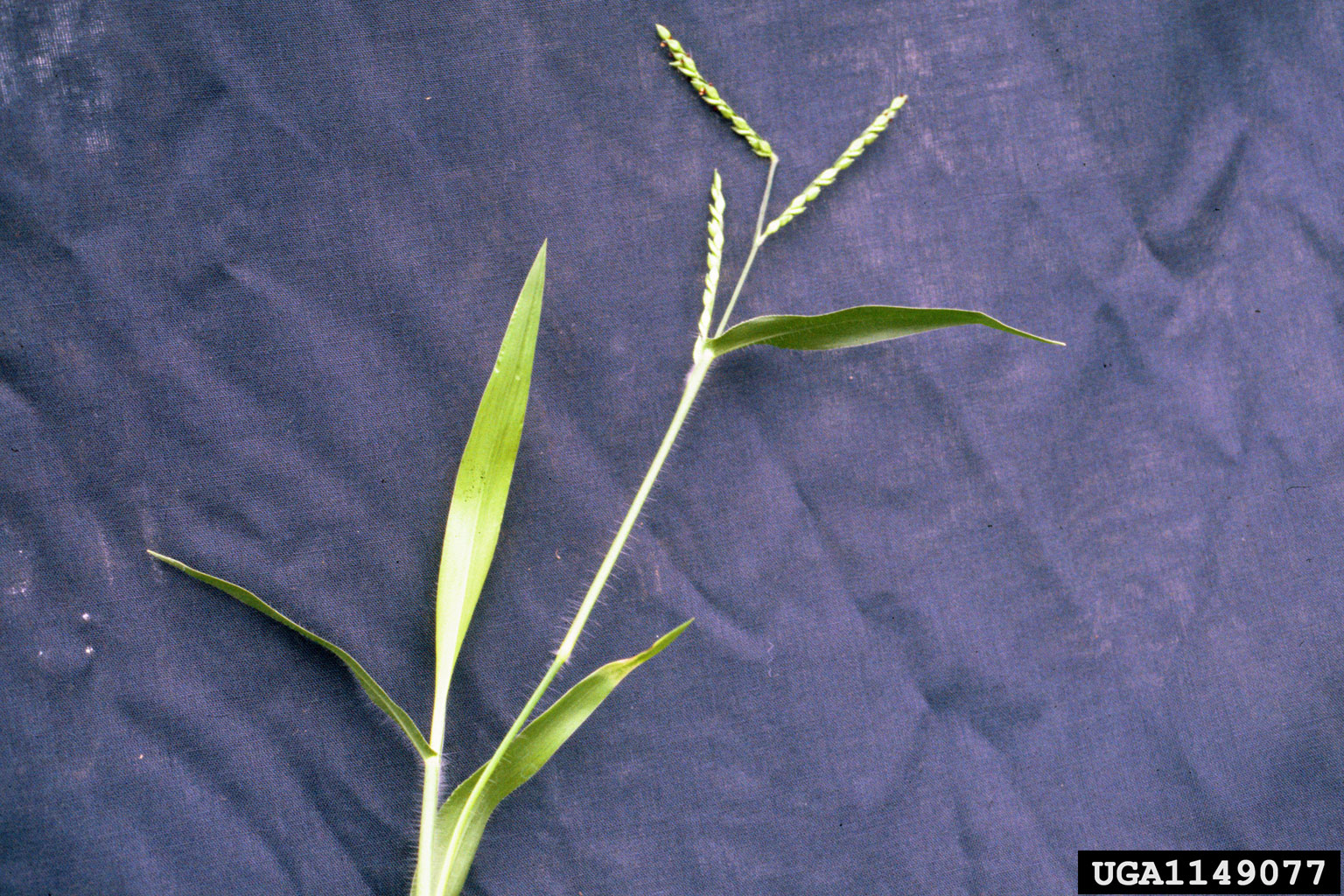- Urochloa panicoides
Taxobox
name = Urochloa panicoides"

image_width = 250px
regnum =Plant ae
divisio = Magnoliophyta
ordo =Liliopsida
classis =Poales
familia =Poaceae
subfamilia =Panicoideae
tribe=Paniceae
genus = "Urochloa "
species = "U. panicoides"
binomial = "Urochloa panicoides"
binomial authority = (L.) P.Beauv."Urochloa panicoides" is a fodder grass originating in
Southern Africa .ynonyms
* "Panicum borzianum" Mattei fide Fl. Trop. E. Africa: 603.
* "Panicum controversum" Steud.
* "Panicum helopus" Trin. in Spreng. [Neue Entdeckungen im Ganzen Umfang der Pflanzenkunde 2: 84. 1821.. 2:84. 1821. Duthie, Fodder Grasses 8. 1888.]
* "Panicum helopus" Trin. f. "glabrescens" K.Schum. fide Fl. Trop. E. Africa
* "Panicum hirsutum" Koen. ex Roxb.
* "Panicum hochstetteranum" A.Rich.
* "Panicum javanicum" Poir.
* "Panicum oxycephalum" Peter
* "Panicum panicoides" (P. Beauv.) Hitchc.
* "Panicum setarioides" Peter - (1928), non Steud. (1854).-- nom.nud.
* "Urochloa helopus" (Trin.) Stapf
* "Urochloa marathensis" Henr.
* "Urochloa marathensis" var. "velutina" Henr.
* "Urochloa ruschii" Pilg.
* "Urochloa panicoides" P. Beauv., Ess. Agrost. 53,
* "Urochloa panicoides" var. "marathensis" (Henr.) Bor.
* "Urochloa panicoides" var. "pubescens" (Kunth) Bor
* "Urochloa panicoides" var. "velutina" (Henr.) Bor
* "Urochloa pubescens" KunthDescription
* Habitat: annual;
caespitose .Culm sgeniculately ascending, ordecumbent ; 10–100 cm long; withoutnodal root s, or rooting from lower nodes.Ligule a fringe of hairs.Leaf-blade base amplexicaul. Leaf-blades linear, orlanceolate ; 2–25 cm long; 5–18 mm wide. Leaf-blade surfaceglabrous , or pubescent. Leaf-blade marginstuberculate -ciliate ; hairy at base.
* Inflorescence:Inflorescence composed ofraceme s. Racemes 2–7(–10); borne along a central axis; unilateral; 1–7 cm long. Central inflorescence axis 1–9 cm long.Rhachi s narrowly winged; angular; glabrous on surface, or with scattered hairs.Spikelet packingabaxial ; regular; 2 -rowed. Spikelets solitary, or in pairs. Fertile spikelets sessile and pedicelled. Pedicels bearing a few hairs.
* Fertile spikelets: Spikelets comprising 1 basal sterile florets; 1 fertile florets; withoutrhachilla extension. Spikelets elliptic; dorsally compressed; compressed strongly; plano-convex; acute; (2.5–)3.5–4.5(–5.5) mm long; falling entire.
* Glumes:Glume s dissimilar; reaching apex offloret s; thinner than fertilelemma . Lower glume ovate; clasping; 0.5(–0.66) times length of spikelet; membranous; without keels; 3–5 -veined. Lower glume surface glabrous, or pubescent. Lower glume apex obtuse, or acute. Upper glume elliptic; 1 times length of spikelet; membranous; without s; 7–11 -veined. Upper glume lateral veins with cross-veins. Upper glume surfaceglabrous , or pubescent. Upper glume apexacuminate .
* Floret: Basal sterile florets male, or barren; withpalea . Lemma of lower sterile floret similar to upper glume; elliptic; 1 times length of spikelet; membranous; 5–7 -veined; glabrous, or pubescent;eciliate on margins, orsetose on margins; acuminate. Fertile lemma orbicular; dorsally compressed; 2 mm long;indurate ; without keel. Lemma surfacerugulose . Lemma marginsinvolute . Lemma apex obtuse;mucronate . Principal lemma awn 0.3–1 mm long overall. Palea indurate. [GrassBase | name = 'Urochloa panicoides" | id = imp10723]"
Urochloa setigera " can be confused with forms of "U. panicoides" with pubescent, paired spikelets, especially when the base is missing. "Urochloa panicoides" has less abruptlycuspidate spikelets, a more coarsely rugose fertilefloret , and a much longer mucro on the upper lemma.Distribution
*
Africa : Botswana, Eritrea, Ethiopia, Kenya, Malawi, Mauritius, Mozambique, Namibia, Somalia, South Africa, Sudan, Swaziland, Tanzania, Uganda, Zambia, Zimbabwe
*Asia : Yemen,India ,Pakistan , Thailand, China (Sichuan, Yunnan).
*Naturalized elsewhere, including Australia, Argentina, and United States.Native to southern Africa.
Ecology
Moist
grassland s, lakesides up to analtitude of 140-2200 m.Usage
A
weed and a potentialseed contaminant . Though often used as afodder grass for bothcattle andhorse s.Diseases and Pests
This grass is susceptible to the
Maize streak virus (MSV) (which is also calledbajra streak,cereal African streak virus,maize streak A virus). This virus is transmitted by the followingCicadellidae insect species:Cicadulina mbila ,Cicadulina arachidis ,Cicadulina ,Cicadulina triangula ,Cicadulina bimaculata ,Cicadulina similis ,Cicadulina latens ,Cicadulina ghaurii ,Cicadulina parazeae . It is also susceptible to theCereal chlorotic mottle nucleorhabdovirus . This too is transmitted by insects: Nesoclutha pallida, Cicadula bimaculata,Cicadulina bipunctata ssp.Bipunctella .Punjabi dialect forms
The following Punjabi
dialect forms are recorded for this grass:
*in India: barajalgauti, harat, basaunta, chaprai Ia. chat ta. gal¬phula. jal-ganti, jalganti. jhun. kaadu hilisamme kaadubilli-saatnal hullo. kakdel. kuwain, kowin. kuri, kuriya, motia. pandhar, poir.salla-woodoo, sallawudu, sam¬wan, semai.Non-Indian languages
* Afrikaans: tuin-urochltta, tuinheesgras, heesgras, cenjarige sinjaalgras, kurimanna, tuingras.
* Chinese: 黍尾稃草 lei shu wei fu cao.
* English: annual signal grass, garden signal grass, garden grass, panic liverseed grass, liverseed grass, liver seed grass, liverseedgrass, herringbone grass, kuri-millet, poke.
** "Australia": urochloa grass, garden urochloa, panic urochloa grass, urochloa.
** "South Africa": garden urochloa.
** "United States": liverseed grass.
*** "Alabama:", "California", Florida, Massachusetts, Minnesota, Oregon, Vermont: liver seed grass; North Carolina: liverseed grass; South Carolina: liverseedgrass
** "Zimbabwe": Kuri millet.
* Italian: pasto africano.
* Somali: farsho.
* Sotho: kgola, kgolane, bore-ba-ntjia.References
Wikimedia Foundation. 2010.
